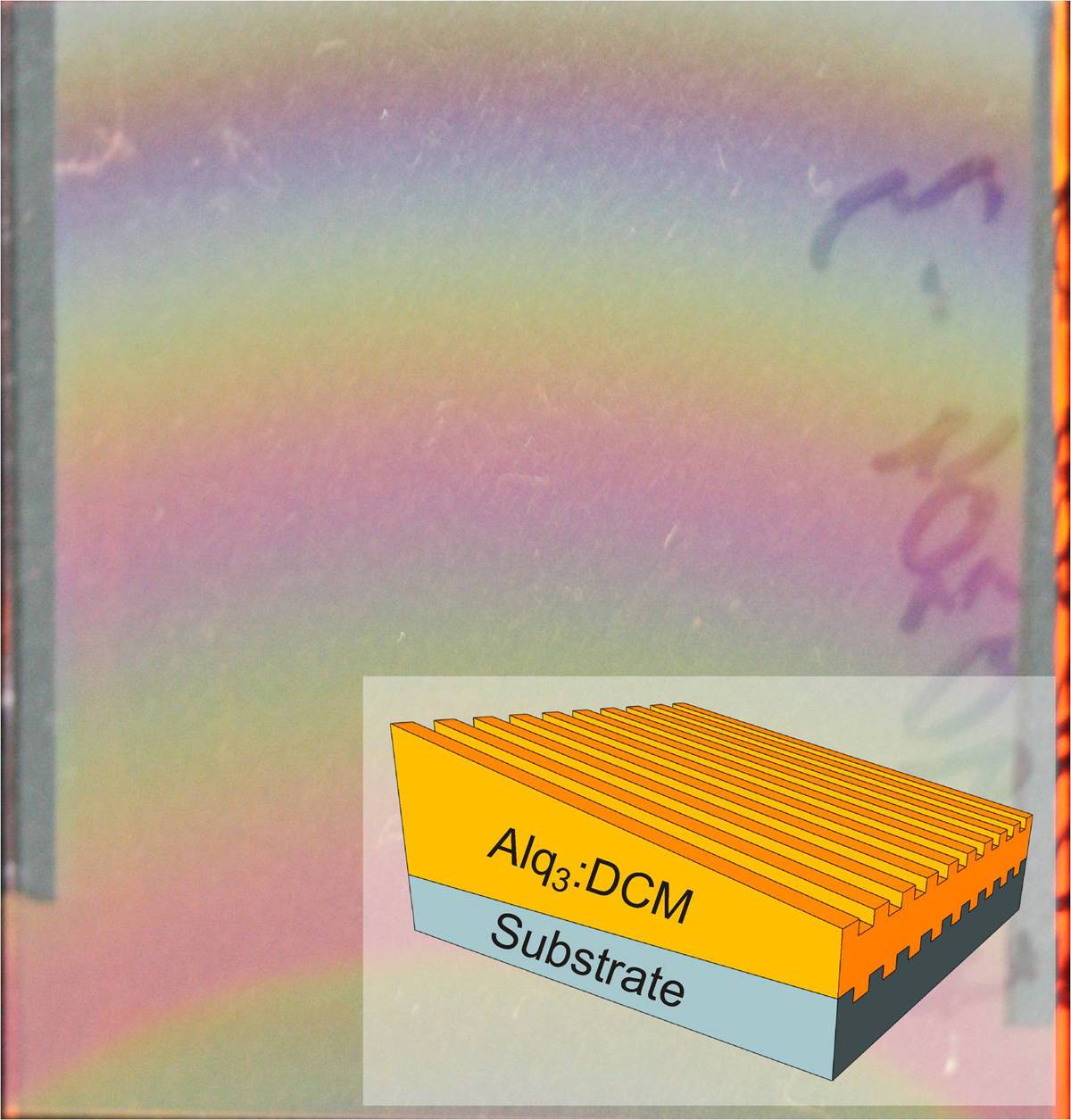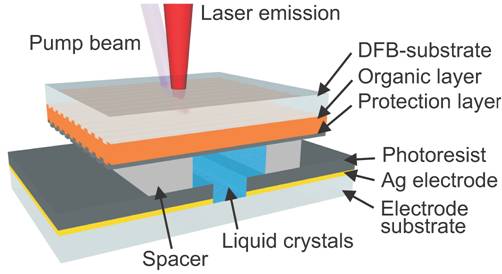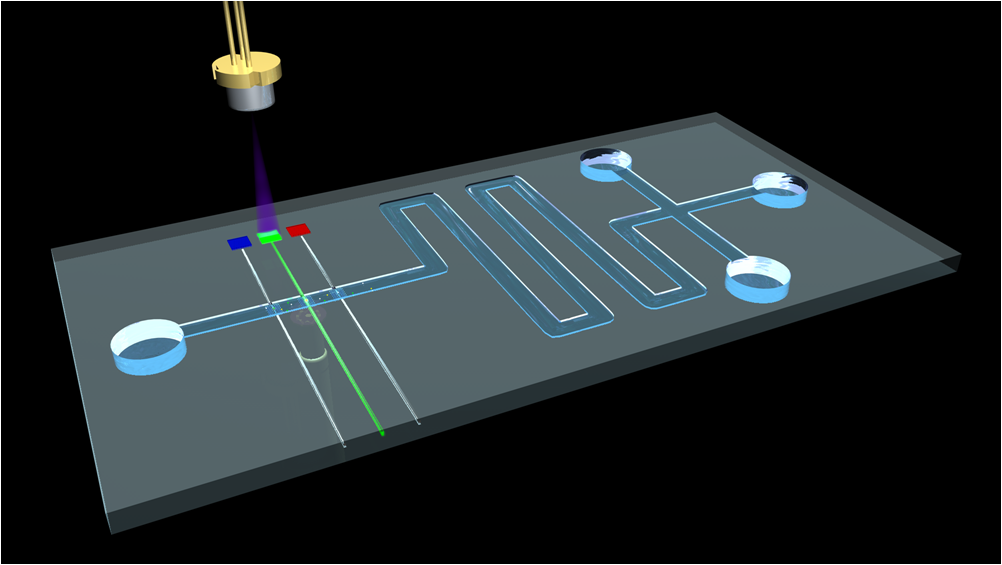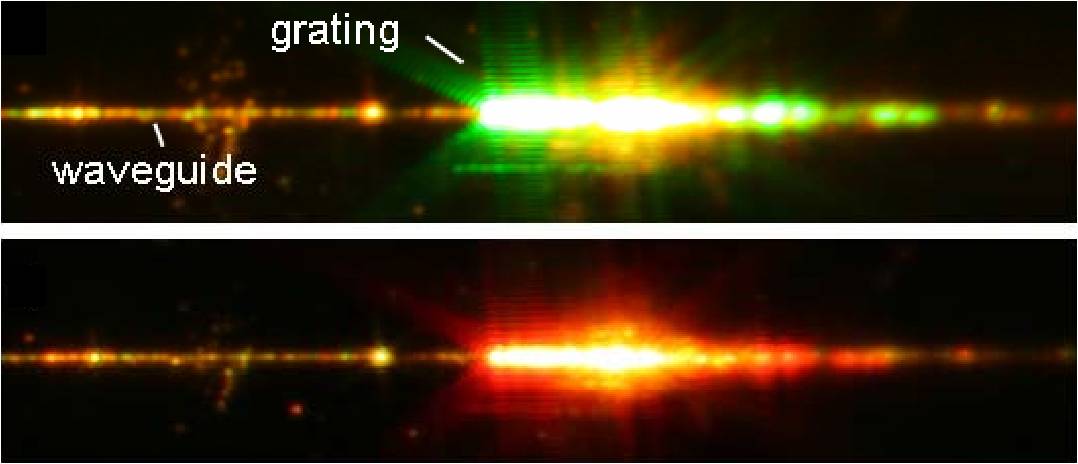A5.5: Organic Nanophotonics for Low-Cost Biosensing
Subproject Leader: Ulrich Lemmer
Light Technology Institute, KIT
Present: Uwe Bog, Soenke Klinkhammer, Xin Liu
Past: Martina Gerken, Nico Heussner, Christian Karnutsch, Marc Stroisch, Christoph Vannahme, Thomas Woggon
Organic Nanophotonics for Low-Cost Biosensing
The aim of subproject A5.5 is the fabrication and use of nano- and microphotonic structures and the integration of organic semiconductor lasers for biosensing and lab-on-chip (LOC) applications. Organic semiconductor materials offer a promising approach towards small, tunable laser devices in the visible spectral range. This group of materials offers a broad spectral gain, a simple and low-cost fabrication process and optical pumping with diode lasers or light emitting diodes. Lasers relying on distributed feedback (DFB) have attracted a lot of interest as they allow fabricating devices with low thresholds and single-mode emission on a wide range of different substrates. These can be integrated into polymeric micro-optical circuits such as LOC systems
Tuneable Organic DFB Lasers
The emission wavelength λlas of a DFB laser of order m with a grating pitch of L can be estimated using Bragg’s principle λlas ≈ 2 neff / m. The effective refractive index neff of the propagating slab waveguide mode depends on the layer thickness and the refractive indices of the different layers. We fabricated broadly tuneable organic DFB laser devices by introducing a wedge-shaped film of the active material on top of the grating substrate. The thickness gradient was obtained with a rotating shadow mask evaporation technique using Alq3:DCM as the active material complex [1]. The laser device enables continuous tuning over a range of 55 nm in the red part of the visible spectrum by simply moving the sample relative to the pump beam. Using an intermediate, wedge-shaped high-index-layer instead of a wedge-shaped active film allows fabricating tuneable organic DFB lasers from solution processable materials by e.g. spin-coating on top of the high-index layer. Furthermore, we developed a technique which allows the direct fabrication of thickness gradients from solution with a meniscus coating technique.
We also investigated wavelength tuning methods based on dynamic refractive index variation which enables electrical rather than mechanical tuning. For doing so, liquid crystals (LCs) were placed on top of a DFB laser. Orientation of the LCs was controlled by applying a voltage to laterally aligned electrodes. This changed the effective refractive index of the waveguide mode and, in turn, the lasing wavelength. Continuous electrical tuning over 4 nm was achieved [2].
Optical Spectroscopy with Organic Lasers
We built a compact optical transmission spectrometer with a continuously tuneable organic distributed feedback laser based on a wedge-shaped active layer as the key element. The system consisted of only a limited number of components. With this system we were able to conduct optical transmission spectroscopy with a spectral resolution and sensitivity comparable or better than commercial spectrophotometer. Furthermore, we showed that tuneable laser light sources enhance laser-induced fluorescence signals when the excitation wavelength of the organic laser is shifted towards the absorption maximum of the fluorescent marker. These findings and the opportunities for commercialization of this technology actually led to the foundation of the spin-off VISOLAS GmbH (www.visolas.de).
Photonic Sensor Platforms with Integrated Organic Lasers
In collaboration with KIT-partners, we fabricated integrated waveguide coupled organic semiconductor lasers. This was achieved by either structuring a waveguide into the substrate underneath the guiding layer of an organic DFB laser or by introducing a topographical step between the grating region of the DFB laser and the waveguide region. The fabrication steps involved hot embossing, deep UV exposure and thermal evaporation of the active material. We also demonstrated a simple encapsulation technique for the organic DFB lasers with the topographical step by bonding a polymer lid on top. In a next step, we fabricated integrated organic DFB lasers and a microfluidic channel in PMMA, connected with each other by a waveguide [3]. By pumping the DFB laser, its emitted light was coupled into the waveguide and guided to the crossing of the waveguide and the microfluidic channel where the DFB laser light excited fluorophores in the microfluidic channel.
Direct laser writing allows the parallel fabrication of almost arbitrary micro- and nanostructures, e.g. surface grating for organic DFB lasers. Thus, different concepts of micro-optical platforms can be evaluated with this rapid prototyping technique.
Alternatively, low-threshold microcavity lasers were fabricated in collaboration with subproject A5.4. Such laser sources provide narrow-linewidth, efficient laser emission which potentially allows the development of sensitive active transducers in biosensing platforms. These can be pumped using low-cost laser diodes [4].
In order to provide a photonic sensor platform that allows the marker-free detection of a small number of molecules, we also investigated a photonic bio-transducer that can easily be combined with deep UV defined waveguides. Using the technique of dip-pen nanolithography, a functional waveguide grating coupler out of phospholipids (DOPC) was patterned onto a waveguide [5]. The DOPC structures were shown to undergo a change of size and shape upon protein binding which also affects the diffraction efficiency. By this, we were able to detect binding of an analyte to the functionalized DOPC gratings with concentrations as low as 5 nMol. Thus, such a grating coupler is one possible route as a transducer for an advanced detection scheme of biologically relevant molecules.
References
|
[1] |
S. Klinkhammer, T. Woggon, U. Geyer, C. Vannahme, T. Mappes, S. Dehm, and U. Lemmer, A continuously tunable low-threshold organic semiconductor distributed feedback laser fabricated by rotating shadow mask evaporation, Appl. Phys. B 97, 787 (2009) |
|
[2] |
S. Klinkhammer, N. Heussner, K. Huska, T. Bocksrocker, F. Geislhöringer, C. Vannahme, T. Mappes, and U. Lemmer , Voltage-controlled tuning of an organic semiconductor distributed feedback laser using liquid crystals, Appl. Phys. Lett. 99, 023307 (2011) |
|
[3] |
C. Vannahme, S. Klinkhammer, U. Lemmer, and T. Mappes, Plastic lab-on-a-chip for fluorescence excitation with integrated organic semiconductor lasers, Opt. Express 19, 8179 (2011) |
|
[4] |
S. Klinkhammer, T. Grossmann, K. Lüll, M. Hauser, C. Vannahme, T. Mappes, H. Kalt, and U. Lemmer, Diode-pumped organic semiconductor microcone laser, IEEE Photon. Technol. Lett. 23, 489 (2011); |
|
[5] |
S. Lenhert, F. Brinkmann, T. Laue, S. Walheim, C. Vannahme, S. Klinkhammer, M. Xu, S. Sekula, T. Mappes, T. Schimmel, H. Fuchs, Lipid multilayer gratings, Nature Nanotechnology 5, 275 (2010) |
List of Publications 2006-2011 as PDF
Subproject Report 2006-2010 as PDF



